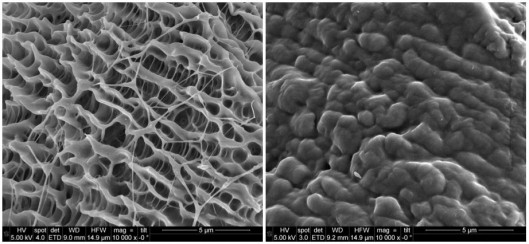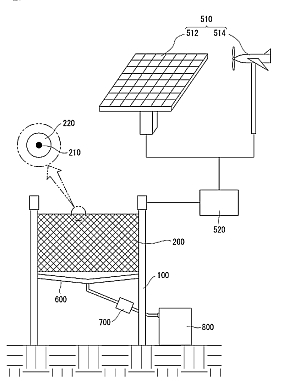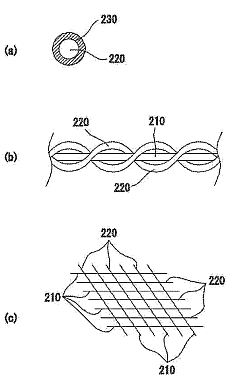rexresearch1
ESTEVES,
Catarina, et al.
Fog Collector
Fog Collector
PNIPAAm
polymer on cotton absorbs 3.4 liter water per kilogram of
fabric
http://www.scidev.net/global/desert-science/news/fog-catching-fabric-could-improve-water-collection-in-deserts-.html
Fog-catching fabric could improve water collection in deserts
A novel and affordable fabric may improve the efficiency of water collection from fog, helping to provide freshwater in desert areas.
Researchers from the Eindhoven University of Technology (EUT), in the Netherlands, and Hong Kong Polytechnic University, China, turned a cotton fabric into a water-collecting material by coating it with a polymer called PNIPAAm.
The fabric switches between absorbing moisture directly from the air when it is foggy and cold, and releasing it as water at warmer temperatures, according to a paper to be published on 21 February in Advanced Materials.
Every kilogramme of the sponge-like fabric can absorb around 3.4 litres of water from the air. When the ambient temperature rises, the material's microstructure changes and the water is released. These processes are repeatable, raising hopes the fabric could act as an autonomous water-collecting device.
The team hopes the material could be used to harvest water in dry coastal areas, such as the Namib Desert, in Namibia, where rainfall is scarce but ocean air currents frequently bring vapour-carrying fogs.
The temperature range within which the fabric collects, and then releases, water is similar to the typical daytime highs and night-time lows seen in deserts.

http://www.tue.nl/en/university/news-and-press/news/cotton-with-special-coating-collects-water-from-fogs-in-desert/
21 January 2013
Cotton
with special coating collects water from fogs in desert

Photo: TU Eindhoven/Bart van Overbeeke
Researchers TU/e together with researchers at the Hong Kong Polytechnic University (PolyU), have developed a special treatment for cotton fabric that allows the cotton to absorb exceptional amounts of water from misty air: 340 % of its own weight. What makes this 'coated cotton' so interesting is that the cotton releases the collected water by itself, as it gets warmer. This property makes of the coated cotton materials a potential solution to provide water to the desert regions, for example for agricultural purposes. The results of this research will be published next month in the scientific journal Advanced Materials.
The researchers applied a coating of PNIPAAm, a polymer, to the cotton fabric. At lower temperatures, this cotton has a sponge-like structure at microscopic level. Up to a temperature of 34°C it is highly hydrophilic, in other words it absorbs water strongly. Through this property the cotton can absorb 340 % of its own weight of water from misty air – compared with only 18% without the PNIPAAm coating.
Totally pure water
In contrast, once the temperature raises the material becomes hydrophobic or water-repellant, and above 34°C the structure of the PNIPAAm-coated cotton is completely closed. When these high temperatures are reached the cotton has released all the absorbed water, which is totally pure. The research shows that this cycle can be repeated many times.
Inspiration from Nature
Beetles in desert areas can collect and drink water from fogs, by capturing water droplets on their bodies, which roll into their mouths. Similarly, some spiders capture humidity on their silk network. This was the inspiration for this new coated-cotton material, which collects and releases water from misty environments simply as the temperature changes throughout the day.
Low-cost material
This property implies that the material may potentially be suitable for providing water in deserts or mountain regions, where the air is often misty at night. According to TU/e researcher dr. Catarina Esteves a further advantage is that the basic material – cotton fabric – is cheap and can be easily and locally produced. The polymer coating increases the cost slightly, but with the current conditions the amount required is only about 12%. In addition, the polymer used is not particularly costly.
Placed directly on the soil
Fine-mesh ‘fog harvesting nets’ are already being used in some mountains and dry coastal areas, but these use a different principle: they collect water from misty air, by droplets that gradually form on the nets and fall to the ground or a suitable recipient. But this system depends on a strong air flow, wind. The coated cotton developed the research team can also work without wind. In addition, cotton fibers coated with this polymer can be laid directly where the water is needed, for example on cultivated soil. The researchers are also considering completely different applications such as camping tents that collect water at night, or sportswear that keeps perspiring athletes dry.
Further optimization
The research was led by professor John Xin at PolyU and dr. Catarina Esteves at TU/e. They now intend to investigate further how they can optimize the quality of the new material. For example they hope to increase the amount of water absorbed by the coated-cotton. Moreover they also expect to be able to adjust the temperature at which the material changes from water-collecting to the water-releasing state, towards lower temperatures.
http://onlinelibrary.wiley.com/doi/10.1002/adma.201204278/abstract
9 JAN 2013
DOI: 10.1002/adma.201204278
Advanced Materials, Volume 25, Issue 8, pages 1150–1154, February 25, 2013
Temperature-Triggered
Collection and Release of Water from Fogs by a Sponge-Like
Cotton FabricHelen Yang, Haijin Zhu, Marco M. R. M.
Hendrix, Niek J. H. G. M. Lousberg, Gijsbertus de
With, A. Catarina C. Esteves, and John H. Xin
A sponge-like cotton fabric autonomously collects and releases water from fogs triggered by typical day-and-night temperature variations. The reversible switching between absorbing-superhydrophilic/releasing-superhydrophobic states results from structural changes of a temperature-responsive polymer grafted on the very rough fabric-surface. This material and concept presents a breakthrough into simple and versatile solutions for collection, uni-directional flow, and purification of water captured from the atmosphere.
KR101369389 -- APPARATUS
FOR PRODUCING WATER
Inventor:CHE JU HEEThe present invention relates to a water obtaining apparatus and, more specifically, to a water obtaining apparatus capable of easily obtaining water and being used even in a place difficult to receive electricity by collecting fog with a simple configuration and absorbing, storing, and discharging water. According to the present invention, the water obtaining apparatus includes: a support means; a fog collecting means connected to the support means to be supported and having a mesh body woven from cotton fabrics coated with a heating wire and poly-N- isopropyl acrylamide (PNIPAAm); a weight sensor measuring the weight of the fog collecting means; a temperature sensor measuring the temperature of the fog collecting means; a power supply means supplying power to the heating wire; a water collecting means arranged under the fog collecting means and collecting water discharged and falling from the fog collecting means; a filter means filtering the water collected in the water collecting means; a storing means storing the water passing through the filter means; and a control means changing the temperature of the fog collecting means by controlling the operation of the power supply means according to the weight of the fog collecting means measured by the weight sensor. The fog collecting means absorbs and stores the water of the fog passing through the fog collecting means, and power is supplied to the heating wire according to the control of the control means. If the temperature of the fog collecting means excesses the determined temperature, the fog collecting means discharges the stored water.

